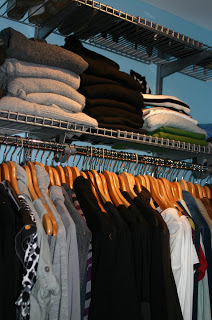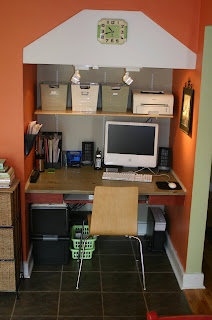Remove everything from the closet and sort into piles – according to use (towels, facecloths, hand towels / bedding, sheets, pillowcases / extra blankets…etc.).
Get rid of towels and linens that are stained or torn. These make great rags for the workshop, gardening shed or for cleaning up the aftermath of arts & crafts!
Fold towels neatly and stack them by size and color. This gives you a practical view of the contents.
Fold linens and stack them by the bed they are used for.
 Hall closets
Hall closets
This is your guests’ first impression of the neatness to your home. It should only contain what is used on a daily basis and all clothes that do not belong there should not be stored there.
Leave empty hangers to hang guest coats.
Keep gloves, mitts, hats and scarves in a basket on the shelf.
Hang umbrellas on the bar or lay on the shelf.
Hang purses and bags on a hanger on the bar.
Boots and shoes should be the only thing on the closet floor. Place them on a rack or clean mat.
Bedroom closets
Don’t be afraid to clear out the clothes that you no longer wear. Bag them up and donate to any number of local charities.
 Sort clothes and re-hang by category – shirts, pants, skirts, dresses, suits…etc – and by color. This makes choosing what to wear much easier!
Sort clothes and re-hang by category – shirts, pants, skirts, dresses, suits…etc – and by color. This makes choosing what to wear much easier!
Organized this way, you get a better handle on what you already have in your closet, so you avoid buying items you already have.
When you declutter or change clothes for the season, hang items on the rod with the hook turned backwards. Each time you wear an item, re-hang it facing forwards. After 6 to 8 months, cull out everything still facing backwards.
Use the one-to-one rule – for every item you purchase, get rid of something you have. This is an effective way to avoid an over-stuffed closet of unworn clothes. You will buy less, wear what you have, and save a startling amount of money.
Home office
A good filing system is key. Take time at the beginning to set this up in a way that works for you. You will increase efficiency and effectiveness. Neat, clean and accessible.
 Unfortunately, you have to go through each piece of paper and decide to keep or toss.
Unfortunately, you have to go through each piece of paper and decide to keep or toss.
(I know, I know…this stinks…and there are at least a million other things you can think of that would be less painful!)
Shred or throw out what you can toss.
Now decide where and how everything kept should be filed.
Not everything needs to be kept indefinitely. Check municipal and other government regulations to confirm how long certain documents (like tax records) need to be retained.
Many statement & bills are now also available on-line. Switch to electronic versions and be amazed how much paper you save.
It’s a good rule of thumb to keep all paid bills for a year, if you need to track annually. But credit card and other bills often don’t need to be saved once reconciled.
File insurance and medical records separately and keep for at least three years.
Use technology, such as a scanners, to help streamline files. Switch from paper to storing “soft” copies in well organized computer files.
Plastic storage boxes, baskets and similar storage solutions are readily available — and better looking then ever! This is the best way to store items and keep them easily accessible.
One word of caution – don’t move the clutter from one room to another. You’ll never finish! Just remember, take small bites. Before you know it, you’ll be a de-cluttering expert. And keeping it up on a daily basis will be second nature.
Good luck!
Hall closets


